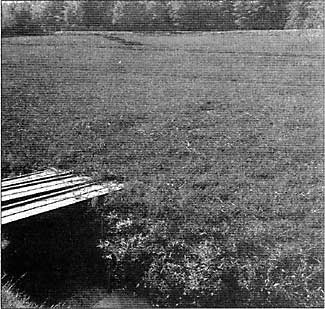
Hanson Express, Oct. 16, 2003
Cranberry season off to a rough start
BY KEITH L. MARTIN
Hanson’s history has rich roots in the cranberry industry, but it
is the roots of bogs around the town that are coming up dry.
 |
| Ellen Stillman still oversees the bogs her father created in the 1940s. |
Because of a wet
spring and an extremely humid summer, cranberry farmers in Hanson and
all over Massachusetts are seeing fewer cranberries in their crop. This
harsh harvest wouldn’t be so bad if it were just one season, but
cranberry growers around the state have experienced hard times for some
time now.
“We are at the end of a real long season where we have had difficulty
with insects really showing an impact on the harvest as well as fruit
rot,” said Jeff LaFleur, Executive Director of the Cape Cod Cranberry
Growers’ Association, “This could potentially be four years
in a row with bad crops.”
LaFleur said that
after two years of USDA-mandated restrictions on supply and last year’s
drought, farmers were looking toward this year to bring better news.
“Prices [of cranberries per barrel] were rebounding a little and
many saw a year to recover and Mother Nature snatched that away,”
said LaFleur.
With Plymouth County the largest cranberry-producing region of the state, LaFleur said that bad harvests will have a serious impact on the USDA's projections for Massachusetts, a state that produces over 25 percent of the United States cranberry crop worth nearly 48 million dollars. For 2003, the USDA’s projection is 1.7 million barrels, an increase from 1.4 barrels last year.
“At this point, I’m not sure I believe we’ll get near [the 2003 projection],” said LaFleur.
This fact has caused many who make a living in cranberries in Hanson and surrounding towns to seek alternative sources of income, said LaFleur, and caused lots of frustration among farmers.
“Imagine it was you or I, working 40 hours a week and when you get your check, 30 percent of it is gone,” he said. “That’s what it is like [for cranberry farmers] working all year to produce a crop and when it is time to harvest, 30 percent of the crop is gone. That’s a substantial blow to these folks financially and emotionally.”
Peter Beaton, one of the owners of Beaton’s Cranberry Growers Service, said that on the 850 acres his company manages in Massachusetts, the crop is definitely lower than he expected.
“I’m not surprised by the low crop, but it is lower than I anticipated so I’m disappointed to a big degree,” said Beaton, echoing LaFleur’s estimates of a 30 percent loss of berries.
The 20 acres of bog Beaton oversees in Hanson belong to Ellen Stillman, a pivotal figure in Hanson’s connection to cranberries. It was in the 1940’s that Stillman convinced her father to cultivate bogs in town as she worked in advertising at Cranberry Canners, which would later merge with two other companies to form the Ocean Spray Cranberry Company. As a former advertising manager and vice president at the company, Stillman knows a lot about cranberries.
She also knows that times have been tough for farmers.
“[My bogs] are seeing half what we had last year,” said Stillman.“The bills, however, are 30 percent higher than last year to maintain the bogs.”
With the past four
years producing more hurt than harvest for Massachusetts farmers, Beaton
said that they needed a good crop this year to continue on.
“This means a little more pain for another year,” he said.
“Every bog needs a certain amount of capital to keep it at a good
degree of productivity. We’re trying to be good growers and that’s
hard with a bad crop while others in Wisconsin and other areas are having
a good crop.
It is this success in other states that keeps companies like Ocean Spray in business.
“Some of the crops have experienced [problems], but we have other opportunities through our cooperative with regions in the other part of the country like Wisconsin and Oregon,” said Ocean Spray spokesperson Denise Perry.
 |
| Bogs like this one in Hanson are turning out as many cranberries as possible, after a spring and summer that brought some wet weather and other problems to farmers. |
Perry added that while Massachusetts farmers are having difficulties. their spirits are still high.
“Everyone is keeping their fingers crossed and holding their breath and waiting.’ she said.
Beaton is also confident growers will persevere, and roll with the punches.
“We’re only 25 percent into the crop year and working on early varieties of berries, so hopefully the late varieties will pick up,” he said.
Long removed from her work in advertising, Stillman still watches the market and said the juice market has dropped for years and is now just barely holding level. To help farmers. she said, the industry should spend more time getting information on the berries to consumers.
"They should push the heath benefits of, cranberries, like the presence of antioxidants,” she’ said. “Also, they need some new ideas and a better variety of products. A lot of people don’t know about cranberries [and their benefits] because it's not promoted.”
© 2003 Hanson
Express. Used by permission.
